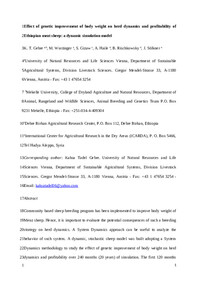Effect of genetic improvement of body weight on herddynamics and profitability of Ethiopian meat sheep: Adynamic simulation model

Authors:
A community-based sheep breeding program has been implemented in the highlands ofEthiopia to improve the body weight of Menz sheep. It is important to evaluate the potentialconsequences of such a breeding strategy on herd dynamics. For this purpose, a dynamic,stochastic herd model was built. The model adopts a system dynamics methodology tostudy the effect of genetic improvement of body weight on herd dynamics and profitabil-ity. The length of the time horizon was 240 months (20 years). The first 120 months servedas a baseline scenario, where the fattening of culled breeding rams was practiced. For thesecond 120 months genetic selection of body weight was introduced considering two sce-narios: culled ram and lamb fattening. Results from the model showed a gradual decrease insheep population size while body weight of the animals improved. The model keeps heavieranimals in smaller flocks to match the herd dry matter demand with the available resources.The simulation also demonstrates that breeding for heavier body weight was considerablymore profitable than the baseline scenario; and lamb fattening was more profitable thanculled ram fattening, as the current practice. Furthermore, voluntary culling may be used tobalance herd size with available feed resources. The introduction of a more intensive sys-tem that provides more feed resources by resourceful smallholders can be used to achievehigher income without reducing flock size. Further work is however needed to evaluate themodel introduced here against field results.
